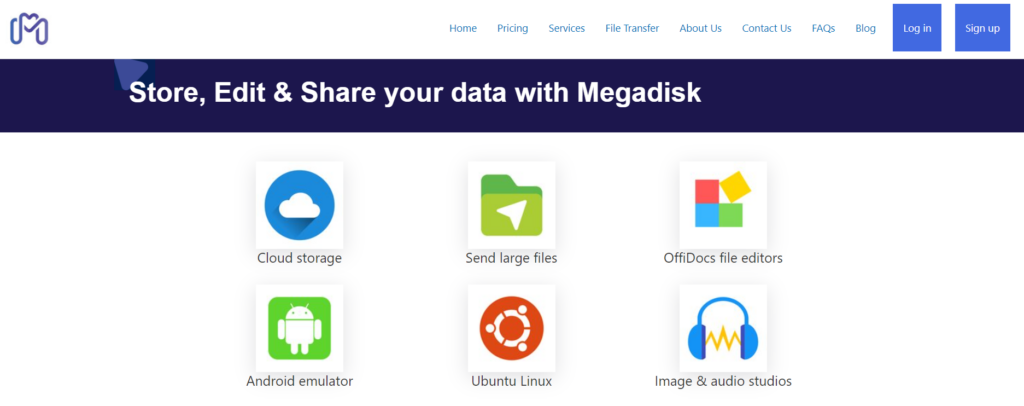In the fast-paced world of software development, efficient data management and collaboration are essential for success. Cloud storage solutions have become invaluable for developers, offering a secure and flexible platform for storing, accessing, and sharing data. This article explores the world of cloud storage for developers, examining its benefits, popular services, best practices, and future trends.
6 Best Cloud Storage Options for Developers
Several cloud storage services are tailor-made to cater to the unique requirements of developers:
1. Megadisk Cloud Storage
Megadisk is much more than just cloud storage for developers, there is a lot more in store than merely storing files. It includes integrations for online Android emulators, Ubuntu servers, Linux servers, video editing and image editing software, online spreadsheets, and whatnot. The best part, it is very economical. There is 10 GB of free cloud storage. Additionally, users can get paid plans starting from € 0.49 with 50GB up to 1TB for just €3.99 a month.

2. Google Cloud Storage
Google Cloud Storage offers a gamut of storage classes, rendering it suitable for diverse development needs. Developers can choose from regional, multi-regional, or nearline storage options, ensuring their data is stored where it matters most.
3. Amazon S3 (Simple Storage Service)
Amazon S3 is renowned for its durability, scalability, and lightning-fast data transfer speeds. Developers entrust Amazon S3 to store and retrieve data for their projects, confident in its reliability.
4. Microsoft Azure Blob Storage
Azure Blob Storage emerges as an ideal choice for developers operating within the Microsoft ecosystem. It offers secure object storage and integrates seamlessly with Azure services, simplifying development workflows.
5. Dropbox
Dropbox, celebrated for its simplicity and ease of use, simplifies file sharing and collaboration among development teams. Developers can leverage Dropbox to share code, documentation, and project assets with team members and clients.
6. GitHub
GitHub, a hub for version control and collaboration among developers, serves as a cloud-based repository for code. It enables development teams to store, manage, and collaborate on code, fostering efficient project management and version control.
How Developers Utilize Cloud Storage
Developers harness the power of cloud storage for various purposes, optimizing their development workflows:
Code Repository and Version Control
Cloud storage services like GitHub and Bitbucket serve as repositories for code, allowing for version control, collaboration, and efficient project tracking. Multiple developers can collaboratively work on a codebase, tracking changes and resolving conflicts with ease.
Collaboration on Projects
The collaborative power of cloud storage enables team members to work on projects concurrently, regardless of their physical location. Code, documentation, and project assets are stored in the cloud, making them accessible to all, and fostering smooth collaboration.
Data Backup and Recovery
Cloud storage solutions are highly effective for data backup and recovery. They serve as a secure and automated solution to protect development assets from data loss, hardware failures, or accidental deletions. Should an unforeseen event occur, developers can quickly recover their data from the cloud, minimizing downtime.
Application Data Storage
Developers utilize cloud storage for the efficient storage of application data. Whether it’s user data, content, or configurations, cloud storage ensures that data is easily accessible, scalable, and resilient. This is especially beneficial for data-driven applications where rapid scaling is a common requirement.

Best Practices for Cloud Storage in Development
Developers can maximize the benefits of cloud storage by adhering to these best practices:
I. Data Security and Encryption
Data security is paramount. Developers should implement encryption for data in transit and at rest. Secure Sockets Layer (SSL)/Transport Layer Security (TLS) should be employed for data in transit, while encryption at rest protects stored data. Access controls must be in place to restrict unauthorized access to sensitive data.
II. Data Backup and Versioning
Regular data backup is critical to safeguard against data loss. Implement data versioning to track changes over time, enabling developers to restore previous states of code or data when necessary.
III. Access Control and Permissions
Access control ensures that only authorized individuals can access specific data and resources. Developers must manage access to their cloud storage diligently, granting permissions based on a need-to-know basis. Regular reviews of access controls are vital to maintain security.
IV. Cost Management
Cost management is a crucial aspect of using cloud storage effectively. Developers should continually monitor their storage usage and explore the use of cost-effective storage classes for different types of data. This approach ensures that costs remain manageable and aligned with the project’s budget.
Challenges and Solutions
a. Data Security Concerns
Developers can address data security concerns by implementing comprehensive encryption measures and robust access controls. Regular security audits and compliance with data protection regulations help maintain data security.
b. Data Transfer Speed
Data transfer speed is essential for efficient development workflows. Developers can optimize data transfer speeds by selecting cloud storage providers known for their fast data transfer capabilities. Additionally, data caching and content delivery networks (CDNs) can be leveraged to minimize latency and improve data access times.
c. Cost Overruns
To prevent cost overruns, developers should closely monitor storage usage. Migrating infrequently accessed data to lower-cost storage classes and optimizing storage utilization can help manage expenses effectively.
d. Data Compliance
Data compliance can be a complex challenge for developers. The solution lies in understanding the specific compliance requirements of their industry and geographic location. Selecting cloud storage solutions that comply with these regulations is crucial to ensure data legality.

Future Trends in Cloud Storage for Developers
The development industry is on the cusp of significant transformations in cloud storage:
Serverless Architecture
The adoption of serverless architecture is gaining momentum. Developers are increasingly turning to serverless platforms that seamlessly integrate cloud storage, simplifying application development and deployment. This trend promises to make development workflows more agile and cost-effective.
Edge Computing Integration
The integration of cloud storage with edge computing is another exciting development. By processing data closer to the data source, edge computing reduces latency and supports real-time applications, enhancing the performance of cloud-connected applications.
Advanced-Data Analytics
Cloud storage services are augmenting their data analytics capabilities. This enables developers to derive valuable insights from the vast volumes of data stored in the cloud. Advanced data analytics can drive better decision-making, enhance application performance, and unlock new possibilities for innovation.
Enhanced Security Measures
Security remains a top priority in the development industry. To address evolving threats, developers can anticipate more advanced security features such as homomorphic encryption and zero-trust security models, ensuring the protection of development data.
Conclusion
Cloud storage has emerged as a linchpin of modern software development. It empowers developers to efficiently store, access, and share data, code, and assets, thereby fostering collaboration and enhancing data management. By adhering to best practices and embracing the latest trends, developers can unlock the full potential of cloud storage, revolutionizing their development workflows.
Whether you’re an experienced developer or a newcomer to the field, cloud storage is a powerful tool that enables you to create, collaborate, and innovate in the ever-evolving world of software development.
FAQs
What is the primary advantage of using cloud storage for development?
The primary advantage is the scalability and accessibility of cloud storage, allowing developers to store, access, and collaborate on data and code effectively.
Which cloud storage service is best for a small development team?
The choice depends on specific project needs, but services like Google Cloud Storage or Dropbox are often suitable for small teams due to their simplicity and cost-effectiveness.
How can developers ensure data security in cloud storage?
Data security can be ensured by implementing encryption, access controls, regular security audits, and compliance with data protection regulations.
What are the potential challenges of using cloud storage in development?
Challenges may include data security concerns, data transfer speed, cost overruns, and data compliance requirements.
What does the future hold for cloud storage in the development industry?
The future includes the adoption of serverless architecture, integration with edge computing, advanced data analytics, and enhanced security measures to address evolving development needs.


